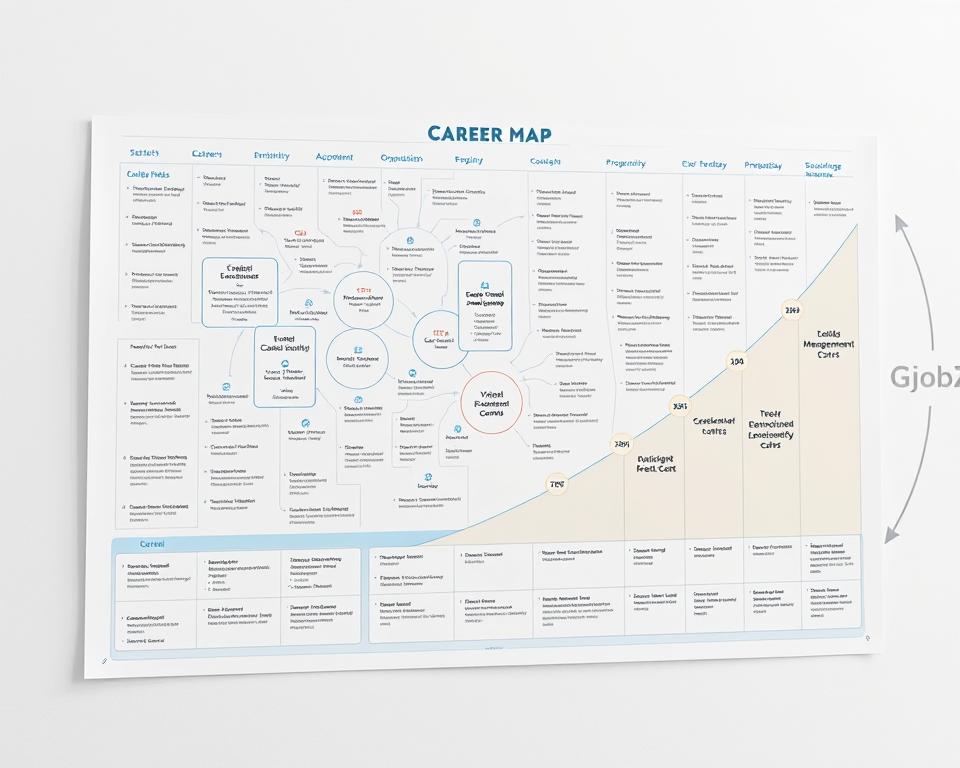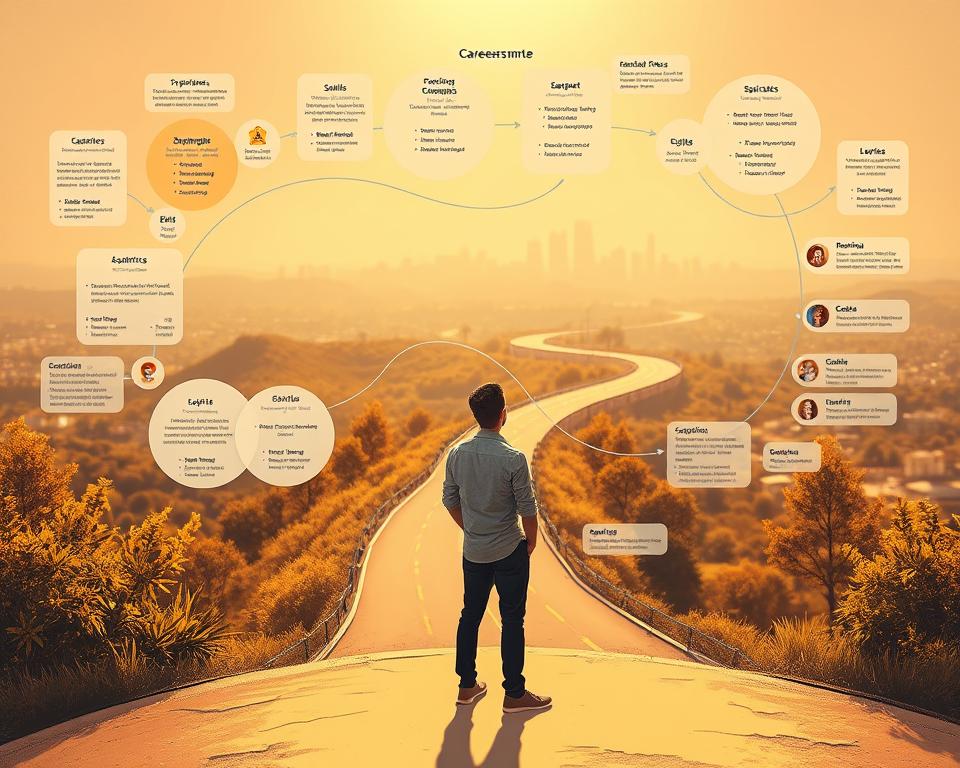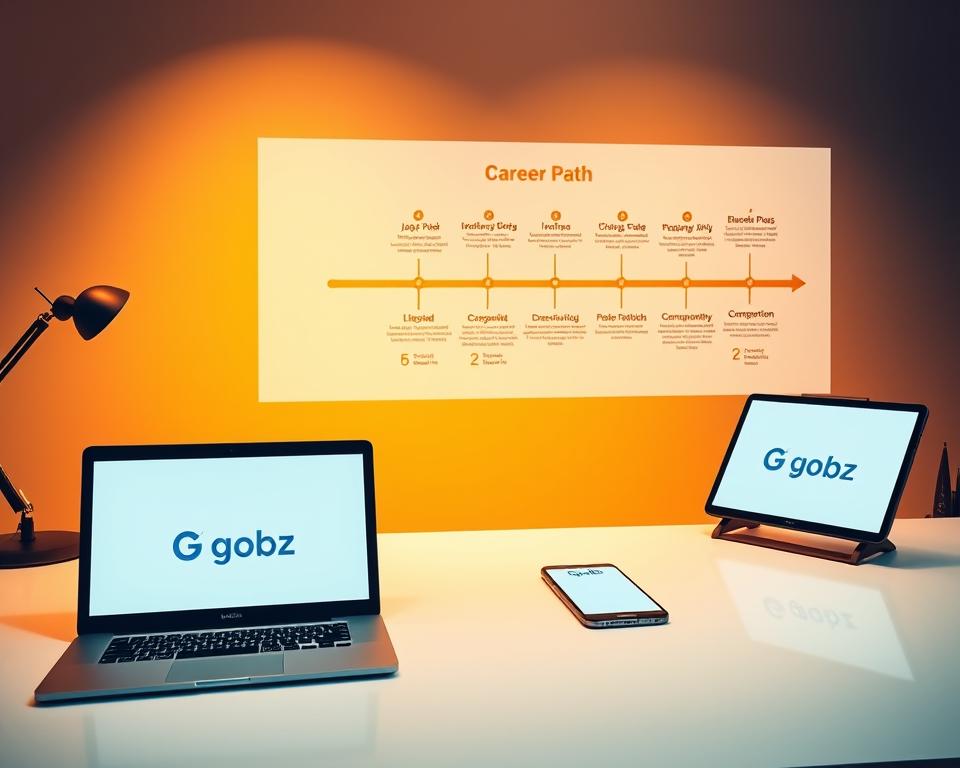
Career Mapping Tools For Promotion
Did you know 67% of U.S. employees say they’d stay longer at a company if they had clarity about their growth path? Yet, only 35% feel their employers provide actionable steps to advance. This gap highlights why visualizing professional journeys matters now more than ever.
Modern workplaces thrive when teams see a clear link between their roles and future aspirations. Tools designed to outline personalized career paths help bridge this divide. Unlike generic progression charts, these resources focus on individual strengths, skills, and goals to create tailored roadmaps.
For example, platforms like HiBob and ClickUp enable employees to identify development opportunities, training needs, and realistic timelines for advancement. Gallup’s 2023 research reinforces this approach: workers who understand their growth potential are 3x more engaged.
By aligning personal ambitions with organizational objectives, these strategies foster loyalty and drive success. They empower individuals to take ownership of their journeys while giving employers a framework to nurture talent from within.
Key Takeaways
- 67% of employees prioritize clarity in advancement opportunities when choosing to stay with a company.
- Personalized planning tools differ from generic charts by focusing on individual skills and goals.
- Leading platforms like Indeed and HiBob help workers visualize actionable steps for growth.
- Gallup data shows tripled engagement when employees see a clear path forward.
- Effective mapping benefits both professional development and organizational retention.
- Alignment between personal aspirations and company needs drives measurable success.
Introduction: The Value of Career Mapping in the Workplace
Imagine knowing exactly how your daily tasks connect to future advancement. That’s the power of structured growth plans. When teams visualize their trajectories, they’re 45% more likely to stay committed to their roles, according to SHRM studies.
Clear progression frameworks eliminate guesswork. They show what skills matter, which learning opportunities exist, and how roles evolve. Gallup found teams with defined paths report 23% higher productivity and 18% lower turnover.
This approach isn’t about rigid ladders. Modern strategies focus on adaptable journeys. Employees might shift laterally, gain certifications, or lead projects—all mapped to their strengths. Internal mobility rises when people see achievable steps toward their aspirations.
Organizations benefit too. Aligning individual goals with company needs creates win-win scenarios. Teams become proactive in development, reducing recruitment costs. One tech firm saw promotions fill 70% of leadership openings after implementing these systems.
Later sections will break down core concepts. You’ll learn how to design frameworks that spark engagement and drive measurable results.
Understanding Career Mapping and Career Pathing Fundamentals
Structured growth plans transform vague aspirations into actionable steps. While often confused, career maps and progression charts serve distinct purposes. One focuses on individuality; the other outlines rigid pathways.

What Is a Career Map vs. a Career Progression Chart?
A career map acts like a GPS for professional journeys. Employees plot skills, interests, and milestones to create flexible routes. For example, a marketing specialist might design a path branching into data analytics or creative leadership.
Progression charts resemble subway maps. They show predefined stops (job titles) and tracks (promotion requirements). These tools help organizations standardize advancement criteria but lack personalization.
| Feature | Career Map | Progression Chart |
|---|---|---|
| Focus | Individual goals | Organizational hierarchy |
| Flexibility | Adaptable routes | Fixed pathways |
| Usage | Self-directed growth | HR policy alignment |
| Outcome | Personalized development | Standardized promotions |
The Role of a Career Framework in Organizational Success
Effective frameworks bridge personal ambitions with company needs. They help managers identify skill gaps during reviews. For instance, a tech firm discovered 40% of engineers needed cloud certifications for upcoming projects.
Employees gain clarity through regular check-ins and goal-tracking tools. This approach reduces turnover – companies with strong frameworks retain staff 2.1x longer according to LinkedIn data.
Implementing Career Mapping Tools For Promotion in Your Organization
What separates thriving companies from stagnant ones? Often, it’s how they connect individual ambitions to team objectives. Effective systems turn vague aspirations into concrete steps forward.

Aligning Career Goals with Organizational Development
Start by auditing existing development programs. Identify where employee skills overlap with upcoming projects. For example, a retail chain trained 120 managers in AI-driven inventory systems to meet expansion goals.
Use platforms like ClickUp to create goal-tracking templates. These tools let workers visualize how mastering Python or leadership training aligns with new roles. A 2023 Lattice report found companies using such methods fill internal promotions 2.4x faster.
Boosting Employee Engagement and Retention
Visibility drives commitment. Share success stories like a customer service rep who became a data analyst through targeted learning paths. Teams with transparent growth plans show 31% higher job satisfaction (McKinsey).
HiBob’s skills-matching dashboards help managers spot talent for emerging needs. One SaaS firm reduced turnover by 19% after showing employees real-time paths to leadership roles. Regular progress reviews and milestone celebrations keep motivation high.
As one HR director noted: “When people see their future within your walls, they invest more deeply in today’s work.” Measure outcomes quarterly—track retention rates, promotion speed, and engagement survey scores to refine your approach.
How to Conduct a Self-Assessment for Career Mapping

What’s the first step to unlocking your professional potential? Start by evaluating where you stand today. A thorough self-assessment helps align personal strengths with organizational needs, creating a roadmap for meaningful growth.
Begin by listing core competencies and achievements. Use platforms like ClickUp to track technical abilities, soft skills, and certifications. One project manager discovered hidden leadership talents through this process, leading to a team lead role within 18 months.
| Assessment Area | Key Questions | Tools |
|---|---|---|
| Skills Inventory | What tasks do I excel at? | Skill matrices |
| Values Alignment | Does my role match my priorities? | Value-sorting exercises |
| Growth Opportunities | Which projects stretch my abilities? | Peer feedback surveys |
Identify gaps by comparing current capabilities to desired roles. For example, an IT specialist aiming for cybersecurity might need specific certifications. Templates often include prompts like:
- “Which tasks energize me most?”
- “What skills have I underutilized?”
- “Where do I need targeted training?”
Set SMART objectives during this phase. A marketing coordinator might aim to master data analytics tools within six months. Regular check-ins ensure progress stays visible and adaptable.
This groundwork transforms vague aspirations into actionable steps. As one HR leader notes: “Clarity in self-evaluation breeds confidence in next moves.”
Setting Short-Term, Mid-Term, and Long-Term Career Goals
Climbing the professional ladder requires more than ambition—it demands a roadmap with clear checkpoints. Structured goal-setting turns abstract aspirations into achievable steps. Research shows workers with time-bound objectives are 50% more likely to advance than those with vague plans.

Techniques for Effective Goal Setting
Break large ambitions into digestible pieces using the 1-3-5 framework: one long-term vision, three mid-term targets, and five immediate actions. For example:
| Time Frame | Objective | Measurement |
|---|---|---|
| 6 months | Complete SQL certification | Exam score & project application |
| 2 years | Lead cross-functional initiatives | Peer feedback & project outcomes |
| 5+ years | Transition to director-level role | Leadership training completion |
Use apps like Trello to visualize progress. A marketing specialist might track:
- Short-term: Master analytics tools (90 days)
- Mid-term: Spearhead campaign strategy (18 months)
- Long-term: Earn VP-level position (5 years)
Quarterly reviews help adjust timelines. As one HR leader notes: “Goals should bend, not break, when priorities shift.” Align personal milestones with team needs—like aligning cloud security training with company infrastructure upgrades.
This approach creates mutual growth. Organizations gain skilled contributors, while individuals gain clarity on their evolving path forward.
Leveraging Templates and Software Solutions for Career Mapping
How do top-performing teams turn aspirations into action plans? The answer lies in choosing the right tools. While traditional templates laid the groundwork, modern platforms revolutionize how professionals chart their growth.

Comparing Traditional Templates and Software-Based Tools
Paper-based templates and spreadsheets once dominated development programs. These static documents outlined basic paths but lacked interactivity. A 2023 survey found 62% of HR teams abandoned PDF templates due to limited customization.
| Feature | Traditional Templates | Software Solutions |
|---|---|---|
| Updates | Manual edits | Real-time sync |
| Collaboration | Email chains | Shared dashboards |
| Progress Tracking | Spreadsheet entries | Automated milestones |
Platforms like ClickUp transform this process. Pre-built functions let employees set skill benchmarks and receive role-specific recommendations. HiBob’s system reduced planning time by 40% for a logistics firm by auto-matching worker strengths to internal openings.
Modern tools also bridge gaps between teams. Managers using Asana can comment directly on development goals, while SlideTeam’s visual roadmaps help workers see how certifications lead to promotions. One tech company saw 31% faster role transitions after adopting these systems.
As one HR director notes: “Dynamic software turns abstract goals into living plans.” Regular updates keep career paths aligned with shifting organizational needs, creating win-win scenarios for growth-focused teams.
Integrating Mentorship and Continuous Learning into Career Map Development
Guided support systems elevate professional growth by merging expertise with personalized feedback. When paired with structured learning, mentorship becomes a compass for navigating complex growth paths. Research shows employees in mentoring programs are 49% less likely to quit.

How Guidance Shapes Professional Trajectories
Effective mentors ask targeted questions to uncover hidden potential. For example:
- “Which projects align with your core values?”
- “What skills would make you irreplaceable in future roles?”
These prompts help workers connect daily tasks to long-term objectives. A SaaS company used biweekly mentoring sessions to reduce leadership pipeline gaps by 33%.
Platforms like Together streamline this process. Their dashboards track progress across development milestones, from certification completion to project leadership. One logistics firm saw 28% faster promotions after implementing tailored mentoring agendas.
Mentorship also fuels succession planning. When senior leaders coach high-potential staff, organizations retain institutional knowledge. A 2023 study found companies with strong mentoring cultures fill 65% of leadership roles internally—twice the industry average.
Conclusion
The future of work demands clarity in professional journeys. Structured career path strategies turn uncertainty into actionable plans, benefiting both individuals and teams. By combining self-assessment with modern software, workers gain visibility into development opportunities that align with their strengths.
Mentorship programs and adaptable frameworks create roadmaps for measurable progress. These systems don’t just boost retention—they prepare organizations for workforce challenges. Companies using personalized growth plans report faster role transitions and stronger succession pipelines.
Success hinges on aligning personal skills development with company objectives. When employees see how their goals contribute to larger missions, engagement and productivity soar. A logistics firm using these methods reduced leadership gaps by 33% within two years.
Ready to transform potential into progress? Begin by auditing current development programs. Identify where advancement tools can bridge skill gaps and fuel organizational agility. The right strategy today builds tomorrow’s resilient, future-ready teams.